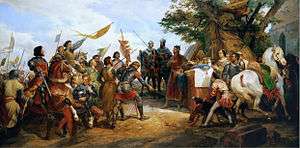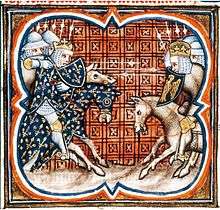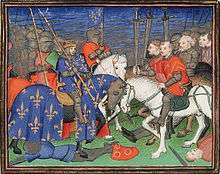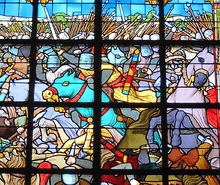Battle of Bouvines
| Battle of Bouvines | |||||||
|---|---|---|---|---|---|---|---|
| Part of the Anglo-French War (1213–14) | |||||||
 La Bataille de Bouvines, by Horace Vernet. (Galerie des Batailles, Palace of Versailles). The white Arabian horse and Moorish attendant (right) of Philippe Auguste at the Battle of Bouvines can be seen in this 19th-century painting. | |||||||
| |||||||
| Belligerents | |||||||
|
|
| ||||||
| Commanders and leaders | |||||||
|
|
| ||||||
| Strength | |||||||
|
25,000 men[2]
|
15,000 men[2] | ||||||
| Casualties and losses | |||||||
|
≈1,000 dead[2] ≈9,000 captured[2] | ≈1,000 dead[2] | ||||||



The Battle of Bouvines, which took place on 27 July 1214, was a medieval battle which ended the 1202–1214 Anglo-French War. It was fundamental in the early development of France in the Middle Ages by confirming the French crown's sovereignty over the Angevin lands of Brittany and Normandy.
Philip Augustus of France defeated an army consisting of Imperial German, English and Flemish soldiers, led by Otto IV, Holy Roman Emperor in the north. Allied with Philip was Frederick II Hohenstaufen, who controlled the southern Holy Roman Empire and afterwards deposed Otto. Other leaders included Count Ferrand of Flanders, William de Longespee and Renaud of Boulogne. Ferrand and Renaud were captured and imprisoned and King John of England was forced to agree to the Magna Carta by his discontented barons. Philip was himself able to take undisputed control of most of the territories in France that had belonged to King John of England, Otto's maternal uncle and ally.
Prelude
In 1214, Ferdinand, Infante of Portugal, and Count of Flanders desired the return of the cities of Aire-sur-la-Lys and Saint-Omer, which he had recently lost to Philip II, King of France in the Treaty of Pont-à-Vendin. He thus broke allegiance with Philip and assembled a broad coalition including Emperor Otto IV, King John I of England, Duke Henry I of Brabant, Count William I of Holland, Duke Theobald I of Lorraine, and Duke Henry III of Limburg.
The campaign was planned by John, who was the fulcrum of the alliance; his plan was to draw the French away from Paris southward towards his forces and keep them occupied, while the main army, under Emperor Otto IV, marched on Paris from the north. John's plan was carried out at first, but the allies in the north moved slowly. John, after two encounters with the French, retreated to Aquitaine on 3 July.
On 23 July, after having summoned all his vassals, Philip had an army consisting of 4,000 cavalry and 11,000-foot soldiers.[3] The emperor finally succeeded in concentrating his forces at Valenciennes, although John was out of the picture, and in the interval Philip Augustus had counter marched northward and regrouped. Philip now took the offensive himself, and in maneuvering to get a good cavalry ground upon which to fight he offered battle (27 July), on the plain east of Bouvines and the river Marque.[4] Otto was surprised by the speed of his enemy and was thought to have been caught unprepared by the King of France[5] (who probably attracted the emperor into this trap[6]). Although he was under a Church interdict,[7] Otto, already an excommunicate,[8] decided to launch an attack on what was then the French rearguard. Philippe Auguste gave battle. His army quickly retreated.
The Allied army drew up facing south-westward towards Bouvines, the heavy cavalry on the wings, the infantry in one great mass in the center, supported by the cavalry corps under the emperor himself.[4] The total force was estimated at 25,000 men; a much larger force of foot soldiers and slightly fewer cavalry than the French.[2] The French army of 15,000 men[2] took ground exactly opposite in a similar formation, cavalry on the wings, infantry, including the town militias in the centre, Philip with the cavalry reserve and the royal standard, the Oriflamme, in rear of the men on foot.[4] Philip's army contained about 2,000 knights (750 were from the royal demesne) and 2,000 mounted sergeants with the rest being infantry.[9]
Order of battle
Even today, the evaluation of forces is controversial. The classic French historiography often refers to Coalition troops three times more numerous than those of the King of France. Philippe Contamine[10] is not of this opinion: "On the face of it, his opponents did not have a clear numerical superiority". It is said by William the Breton, chaplain to Philip at the Battle of Bouvines, that the lines of soldiers stood in line in a space of 40,000 steps (15 ha or 37 acres),[11] which leaves very little clearance and predisposes to hand-to-hand fighting (melee). William the Breton also says in his column that "the two lines of combatants were separated by a pretty small space".
Philip Augustus had then launched an appeal to the municipalities in northern France, in order to obtain their support.
Seventeen of the thirty-nine municipalities of the royal demesne answered the call for militia:
- Arras sent 1,000 men.
- Abbeville region sent 2,000 men.
- Paris sent a corps of 2,000 men, 1,750 of whom fought on the battlefield.[12]
In total, the royal army totalled 7,000 soldiers.
The royal army was divided into three parts:
- The right wing, composed of knights of Champagne and Burgundy, was commanded by the Duke of Burgundy Eudes and his lieutenants: III Gaucher de Châtillon Count of Saint-Pol, Count Wilhelm I of Sancerre, Count of Beaumont and Mathieu de Montmorency and Adam II Viscount of Melun. In the front of the right wing were men of arms and militia from the parishes of Burgundy, Champagne, and Picardy led by mounted sergeants from Soissons.
- The central battle was conducted by Philip Augustus and his chief knights – William des Barres, Bartholomew of Roye, Girard Scophe known as "Girard the Sow",[13] William of Garland, Enguerrand III de Coucy and Gautier de Nemours. In front of the king and his knights were infantry from the towns of Île de France and Normandy.
- The left wing, composed of knights and foot soldiers was led by Robert of Dreux, and Count William of Ponthieu. The main body of the left wing consisted of Breton police and militia from Dreux, Perche, Ponthieu, and Vimeux.
The bridge of Bouvines, the only means of retreat across the marshes, was guarded by 150 sergeants at arms of the king who formed the only reserve for the French.
Otto also divided his army into three groups:
- The left flank, under the command of Ferrand of Flanders with his Flemish knights – directed by Arnaud of Oudenaarde. The soldiers were from Flanders and Hainaut.
- The centre under the command of Otto and of Theobald Duke of Lorraine, Henry Duke of Brabant, and Philip Courtenay Marquis of Namur: together with many Saxon soldiers, knights, and infantry from Brabant and Germany. In front of the centre stood German infantry phalanxes formed deep, bristling with pikes and flanked by companies formed at each corner, then in the second line the Saxon infantry in reserve. Otto stood in between surrounded by 50 German knights.
- The right flank, under the command of Renaud de Dammartin, included equally Brabant infantry and English knights – under the command of the Earl of Salisbury William Longespée.
At the extreme right, the English archers supported the flank of both the Brabant infantry and the nobles of the two Lorraines.[14]
Battle
The battle opened with a simultaneous cavalry charge between the French right and the Flemish left. The French quickly routed the Flemings, who retreated.[15] The serious fighting was between the two centers. The infantry of the Low Countries, who were at this time among the best in Europe, drove back the French. Philip led the cavalry reserve of nobles and knights to retrieve the day, and after a long and doubtful fight (in which he himself was unhorsed and narrowly escaped death), began to drive back the Flemings.[4]
Meanwhile, on the French left Robert de Dreux's troops are at first pressed by men led by William Longespée and Renaud de Dammartin are forced to defend the Bouvines bridge foot by foot. William Longespée was unhorsed and taken prisoner by Philip of Dreux, (a.k.a. the fighting Bishop of Beauvais) and the English soldiers fled. Mathieu de Montmorency captured twelve enemy banners (in memory of this feat, the shield of Montmorency includes an additional twelve eagles or sixteen altogether instead of four previously[16]).
On the other wing the French at last routed the Flemish cavalry and captured Ferdinand, Count of Flanders, one of the leaders of the coalition. In the centre the battle was now a melee between the two mounted reserves led by the King and the Emperor in person. Here too the Imperial forces suffered defeat, Otto himself being saved only by the devotion of a handful of Saxon knights.[4] The Imperial Eagle Standard was captured by the French.
The day was already decided in favour of the French when their wings began to close inwards to cut off the retreat of the imperial centre. The battle closed with the celebrated stand of Reginald of Boulogne (Renaud de Dammartin), a former vassal of King Philip, who formed a ring of seven hundred Brabant pikemen, and not only defied every attack of the French cavalry, but himself made repeated charges or sorties with his small force of knights. Eventually, and long after the Imperial army had begun its retreat, the gallant schiltrom formation was ridden down and annihilated by a charge of three thousand men-at-arms. Reginald was taken prisoner in the melee. The prisoners also included two other counts, Hainaut Ferrand and William Longespée, twenty-five barons and over a hundred knights. The death toll amounted to about 170 knights of the defeated party, and many thousands of foot soldiers on either side.[4]
Aftermath
According to Jean Favier, Bouvines is "one of the most decisive and symbolic battles in the history of France".[17] For Philippe Contamine, "the battle of Bouvines had both important consequences and a great impact".[18]
Philip returned to Paris triumphant, marching his captive prisoners behind him in a long procession, as his grateful subjects came out to greet the victorious king. In the aftermath of the battle, Otto retreated to his castle of Harzburg and was soon overthrown as Holy Roman Emperor by Frederick II, who had already been recognized as emperor in the south a year and a half prior. Count Ferdinand remained imprisoned following his defeat, while King John obtained a five-year truce, on very lenient terms given the circumstances.
Philip's decisive victory was crucial in ordering politics in both England and France. In the former, so weakened was the defeated King John of England that he soon needed to submit to his barons demands and agree to the Magna Carta, limiting the power of the crown and establishing the basis for common law.[19] In the latter, the battle was instrumental in forming the strong central monarchy that would characterize France until the first French Revolution. It was also the first battle in the Middle Ages in which the full value of infantry was realized.[20]
Philip conquered most of Plantagenet's continental possessions, namely Anjou, Brittany, Maine, Normandy, and the Touraine, leading to the effective end of the Angevin Empire.
Commemoration
In thanksgiving for the victory, Philip Augustus founded the Abbey of Notre Dame de la Victoire, between Senlis and Mont l'Evêque.[21]

In 1914, to mark the seventh centenary, Félix Dehau had the parish church of Bouvines rebuilt with a number of stained-glass windows representing the history of the battle.[22]
In 2014, the eighth centenary was commemorated in Bouvines by an association called Bouvines 2014. A serie of events, including an official ceremony and a show called "Bouvines la Bataille" gathering more than 6000 viewers in Bouvines.[23]
Documentaries about the battle
The battle of Bouvines is the subject of one episode of the french documentary series "Butterfly effect" ("Points de repères" in french) broadcast on Curiosity Stream in 2016, called "King Philippe of France and Richard The Lionheart of England".[24]
References
- Georges Duby, The Legend of Bouvines (1990). In a careful study of the historiography of a single event, Duby examines how the Battle of Bouvines has been used and abused in French history.
Wargames
- Frédéric Bey, Swords of Sovereignty: Bouvines 1214 and Worringen 1288, Au Fil de l'Épée series, Ludifolie Editions (2012).
- [Rob Markham] Age of Chivalry Quad - [3w wargames 1992]
External links
- Historical accounts
- Bouvines: the battle in the context of the campaign in the war of 1202–1214
Citations
- ↑ The government of Philip Augustus: foundations of French Royal power in the Middle Ages. University of California Press. 1986. p. 381. ISBN 978-0-520-07391-3. Retrieved 28 April 2013.
- 1 2 3 4 5 6 7 8 9 10 See xenophongroup - Bouvines
- ↑ Batailles française 1214 à 1559 du colonel Hardÿ de Périni
- 1 2 3 4 5 6
 One or more of the preceding sentences incorporates text from a publication now in the public domain: Chisholm, Hugh, ed. (1911). "Bouvines". Encyclopædia Britannica. 4 (11th ed.). Cambridge University Press. pp. 336–337. This cites:
One or more of the preceding sentences incorporates text from a publication now in the public domain: Chisholm, Hugh, ed. (1911). "Bouvines". Encyclopædia Britannica. 4 (11th ed.). Cambridge University Press. pp. 336–337. This cites:
- Charles Oman, History of the Art of War, vii. pp. 457-480
- Kõhler, Kriegsgechichte, &c., i. 140
- Delpech, Tactique au XIIIe siècle, 127.
- ↑ The chroniclers say that Otto also strongly expressed his surprise to find himself facing the French army, while he believed they were on the run.
- ↑ This is the hypothesis of the rhyming chronicles by Philippe Mousket: "At the approach of night, gathered the council, between him and his barons, For the good king, with his armies (around 21,555) wanted to go to Mortagne. But those of his followers knew not how to advise him. When everyone had said his piece, with the best of intentions, (v.21560) Girard the Sow spoke : "Sire, will you not go there; Truly, there are difficulties and harshness, and there are also three large villages and two small rivers beyond (v.21565) that prevent us passing to reach this place. But if you return towards your land, and the Flemings, who want war, if you turn back, will say that you flee, (v.21570) And when you follow this path with pride, with confidence, without any order, as all of us want to be Sire, and you, without crown or anger. Command a good rearguard, (v.21575) So that they are never separated. And also save your battles, and keep your soldiers close to their arms as a ruse. They will be ready if they are attacked. (v.21580) When you see the Flemings coming, they will be at your convenience." Everything was well accepted, and nothing more was discussed. they all went to sleep, (v.21585) And when the day came, the king drew up his battle, and made his orders to the troops. The carting and pack animals left the front during this time. (v.21590) "
- ↑ The Elne synod decreed in 1027, that "It is prohibited to attack the enemy from the ninth hour on Saturday until the early hours of Monday"
- ↑ Otto IV had promised Innocent III large territorial gains and support in the kingdom of Sicily. For failing to honour these promises, he was excommunicated in 1210 and 1211.
- ↑ J. Bradbury, Philip Augustus: King of France 1180–1223, 283
- ↑ The opinion of Philippe Contamine
- ↑ La Philippide de Guillaume le Breton
- ↑ Dictionary of streets and monuments in Paris and Louis Felix Lazarus 1879 Chapter III Page 13
- ↑ Girard Scophe was called the Sow, due to the Latin equivalent of his name: scrofa
- ↑ i.e. Duchy of Lorraine and County of Bar
- ↑ Devries, Kelly, Martin Dougherty, Ian Dickie, Phyllis G. Jestice, and Christer Jorgensen. Battles of the Medieval World: 1000-1500. New York: Barnes & Noble, 2006. p. 80-89.
- ↑ Gabriel Eysenbach, History of Heraldry and the Science of Coats-of-Arms, 1848, p. 321. (Fr)
- ↑ Dictionnaire de la France médiévale, Paris, Fayard, 1993, p. 176
- ↑ Histoire militaire de la France (tome 1, des origines à 1715), Paris, PUF, 1992, p. 83
- ↑ Halfond, Gregory I (2015). The Medieval Way of War: Studies in Medieval Military History in Honor of Bernard S. Bachrach. Ashgate Publishing, Ltd. pp. 251–253. ISBN 978-1-4724-1958-3.
- ↑ Smedley, Edward. The History of France, from the Final Partition of the Empire of Charlemagne to the Peace of Cambray, p. 72, London: Baldwin and Cradock, 1836.
- ↑ Auguste Morel, De Paris à Cologne, à Bruxelles, à Senlis, à Laon... itinéraire descriptif et historique, Libr. de L. Hachette et Cie., 1864, p. 280
- ↑ Association Bouvines 2014 Le 700e anniversaire en 1914
- ↑ Bouvines la Bataille Son et lumière
- ↑ http://www.imdb.com/title/tt5120884/?ref_=fn_al_tt_2
Coordinates: 50°35′0″N 3°13′30″E / 50.58333°N 3.22500°E